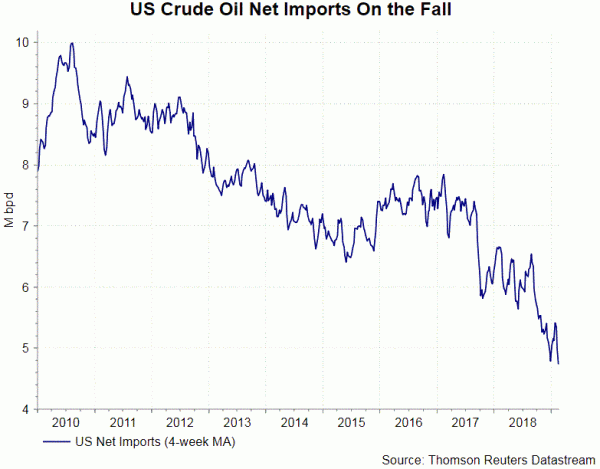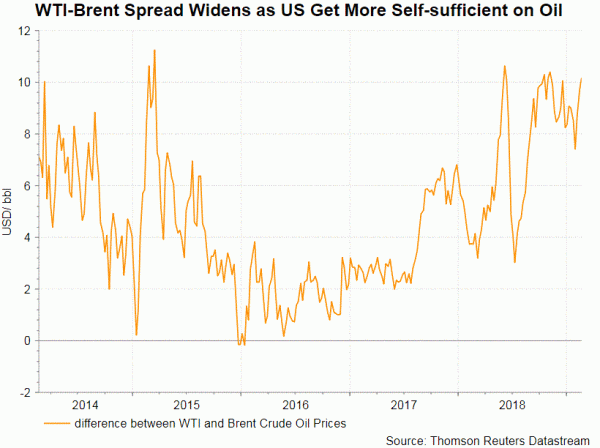Crude oil prices rallied, sending the WTI and Brent benchmarks to the highest level since November 2017. Investors shrugged off rising US shale rig counts and higher inventory, but focused on hopes of resolution to US-China trade war. Adding to the optimism was OPEC compliance and ongoing sanctions against Venezuela and Iran. we expect the recent rally to be short-lived. We do not see structural change in the fundamentals of crude oil market to sustain the price strength. Rather, we expect global economic slowdown would drag crude oil demand. On the supply side, while the latest data suggest that OPEC compliance appeared high in January, the actual cut remained below the pledged cut. Meanwhile, US shale production has over the past year replaced OPEC (or Saudi Arabia) as the swing producer that could affect price. US shale investment could ramp up rather rapidly as oil prices increase. Meanwhile, higher exports from the US in coming years would also put a lid on the price.
In summary, OPEC+ did trimmed output in January. Yet, looking into details, the production reduced was not as substantial as news headlines suggested. According to official OPEC report, OPEC-11 produced 26.05M bpd last month, down from 26.73M bpd in December. The compliance level was 85.6%. According to the deal, these members should have lowered output by -0.812M bpd to 25.94M bpd. As such, the actual production in January was indeed higher, by +0.11M bpd, than what is agreed upon. However, OPEC’s data could be subject to exaggeration. If we take a look at Reuter’s estimate, OPEC-11’s output was 26.18M bpd last month, exceeding the target by 0.24M bpd and with a compliance level of 70%. If we use the average of the above two sources and include the data of the ten non-OPEC countries that agreed to reduce output, the overall compliance level was about 61%.
US shale gas boom since 2015 has great improved self-sufficiency of the country’s oil demand. While remaining net importer of crude oil, the amount has declined significantly from above 8M bpd in 2017 to 3.85M bpd in the week ended February 8. Meanwhile, US’ crude oil exports have soared after the government lifted the exports ban in 2015. Although the export size is still limited when compared with oil giant Saudi Arabia, more supply in the market is still negative for prices.

On the demand side, global economic slowdown would still continue even after the US and China resolves their trade disputes. As we mentioned in the previous report, while China might eventually agree to import significantly import more goods from the US, it takes much longer time to deal with conflicts regarding technologies, cyber security and intellectual property rights. As such, uncertainty in global economies should linger. Country- specific data in the US and China, the two largest oil consumers in the world, have evidenced weakness in growth. Headline CPI in China eased to +1.7% y/y in January, missing consensus of and December’s +1.9%. The slowdown was mainly driven by food price which fell -0.6 percentage point to +1.9%. Non-food inflation steadied at +1.7%. PPI decelerated sharply to +0.1% y/y, from +0.9% a month ago. The market had already anticipated a significant slowdown of +0.2% but the actual figure was even worse. More activity data would be due in coming weeks. The market has revised lower their forecasts on US GDP growth in 4Q18. following a strong second and third quarter, at 4.2% and +3.4% respectively, growth in the last quarter of last year likely faltered below +3%. Growth is expected to decelerate further this year. Risks are thus skewed to the downside for their demand on oil.
OPEC+ Output and Compliance to Reduction (January 2019)
| M bpd | Crude Oil Output in January 2019 | Baseline for cut | Pledged cut | ||
| Opec-11 | Opec | Reuters | average | ||
| Algeria | 1.04 | 1.06 | 1.05 | 1.057 | 32 |
| Angola | 1.42 | 1.45 | 1.43 | 1.528 | 47 |
| Congo | 0.31 | 0.32 | 0.32 | 0.325 | 10 |
| Ecuador | 0.52 | 0.52 | 0.52 | 0.524 | 16 |
| Equatorial Guinea | 0.12 | 0.12 | 0.12 | 0.127 | 4 |
| Gabon | 0.19 | 0.19 | 0.19 | 0.187 | 6 |
| Iraq | 4.67 | 4.65 | 4.66 | 4.653 | 141 |
| Kuwait | 2.71 | 2.71 | 2.71 | 2.809 | 85 |
| Nigeria | 1.79 | 1.84 | 1.82 | 1.738 | 53 |
| Saudi | 10.21 | 10.25 | 10.23 | 10.633 | 322 |
| UAE | 3.08 | 3.07 | 3.07 | 3.168 | 96 |
| opec 11 – total | 26.05 | 26.18 | 26.12 | 26.749 | 812 |
| Non-opec | 0 | ||||
| Azerbaijan | 0.79 | 0.797 | -20 | ||
| Bahrain | 0.21 | 0.217 | -5 | ||
| Brunei | 0.11 | 0.115 | -3 | ||
| Kazakhstan | 2.08 | 2.028 | -40 | ||
| Malaysia | 0.69 | 0.698 | -15 | ||
| Mexico | 1.94 | 1.993 | -40 | ||
| Oman | 0.98 | 1.003 | -25 | ||
| Russia | 11.71 | 11.747 | -230 | ||
| South Sudan | 0.12 | 0.124 | -3 | ||
| Sudan | 0.07 | 0.074 | -2 | ||
| Non-OPEC total | 18.702 | 18.796 | -383 | ||
| ‘OPEC+’ (OPEC 11 and non-OPEC-10) | 45 | 46 | 1195 | ||
| Average compliance level | 60.70% | ||||












